ART NEWS:Feb.01
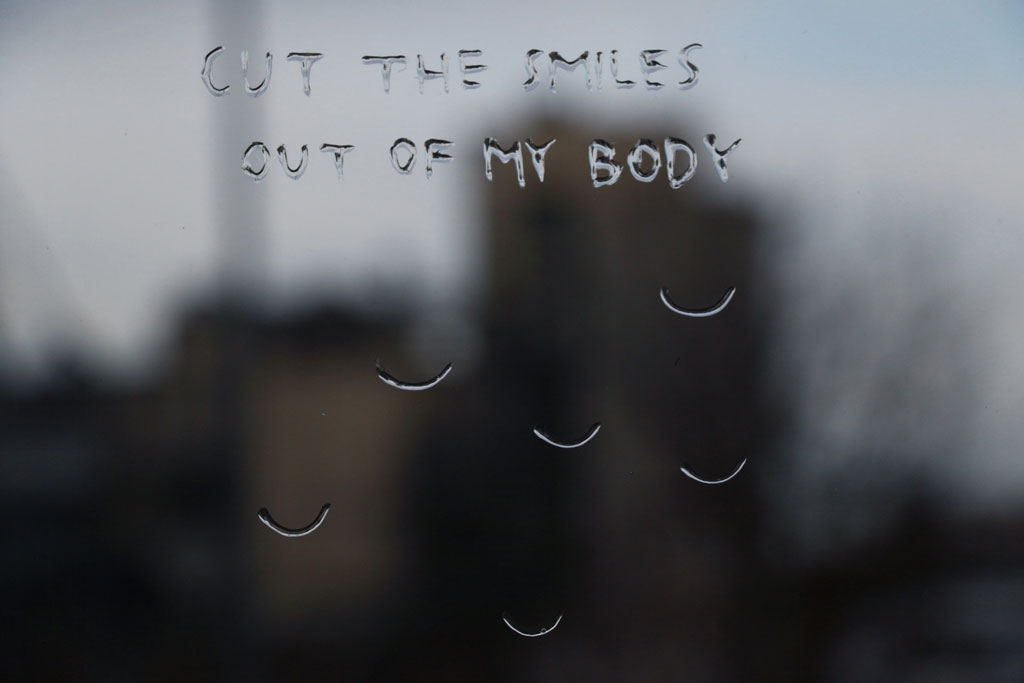 For her site-specific work “Perspectives” (2020) Esther Adam draws linguistic and graphic analyses on the wide glass front of the GAK project room using transparent window color. This hardly visible, subtle artistic work is a message intended exclusively for attentive observers. For at first only a physically empty exhibition space can be seen. In order to recognize that it is at the same time full of thought fragments, it is necessary to reposition oneself in front of the glass surface and thus also the work of art itself, to change perspectives again and again – otherwise what is seen will disappear or become an illegible trace. This dynamic relationship, which encompasses the movement and spatial engagement of the viewer, finds its parallel in what is depicted. In word and image, Esther Adam explores the relationship of the individual human being to his/her world or environment. Circles, arrows and other diagrammatic signs are repeatedly found between the terms “I” and “We”, between personal thoughts and universal themes, indicating a relationship of dependence: the relationship of the individual with his fears, his vulnerability, his existence in the face of the influences of collective processes and social situations, of media and cultural phenomena, and in the face of their own codes and power systems. Info: Curator: Regina Barunke, GAK Gesellschaft für Aktuelle Kunst, Teerhof 2q, Bremen, Duration: 1/2-1/3/20, Days & Hours: Tue-Sun 11:00-18:00, https://gak-bremen.de
For her site-specific work “Perspectives” (2020) Esther Adam draws linguistic and graphic analyses on the wide glass front of the GAK project room using transparent window color. This hardly visible, subtle artistic work is a message intended exclusively for attentive observers. For at first only a physically empty exhibition space can be seen. In order to recognize that it is at the same time full of thought fragments, it is necessary to reposition oneself in front of the glass surface and thus also the work of art itself, to change perspectives again and again – otherwise what is seen will disappear or become an illegible trace. This dynamic relationship, which encompasses the movement and spatial engagement of the viewer, finds its parallel in what is depicted. In word and image, Esther Adam explores the relationship of the individual human being to his/her world or environment. Circles, arrows and other diagrammatic signs are repeatedly found between the terms “I” and “We”, between personal thoughts and universal themes, indicating a relationship of dependence: the relationship of the individual with his fears, his vulnerability, his existence in the face of the influences of collective processes and social situations, of media and cultural phenomena, and in the face of their own codes and power systems. Info: Curator: Regina Barunke, GAK Gesellschaft für Aktuelle Kunst, Teerhof 2q, Bremen, Duration: 1/2-1/3/20, Days & Hours: Tue-Sun 11:00-18:00, https://gak-bremen.de
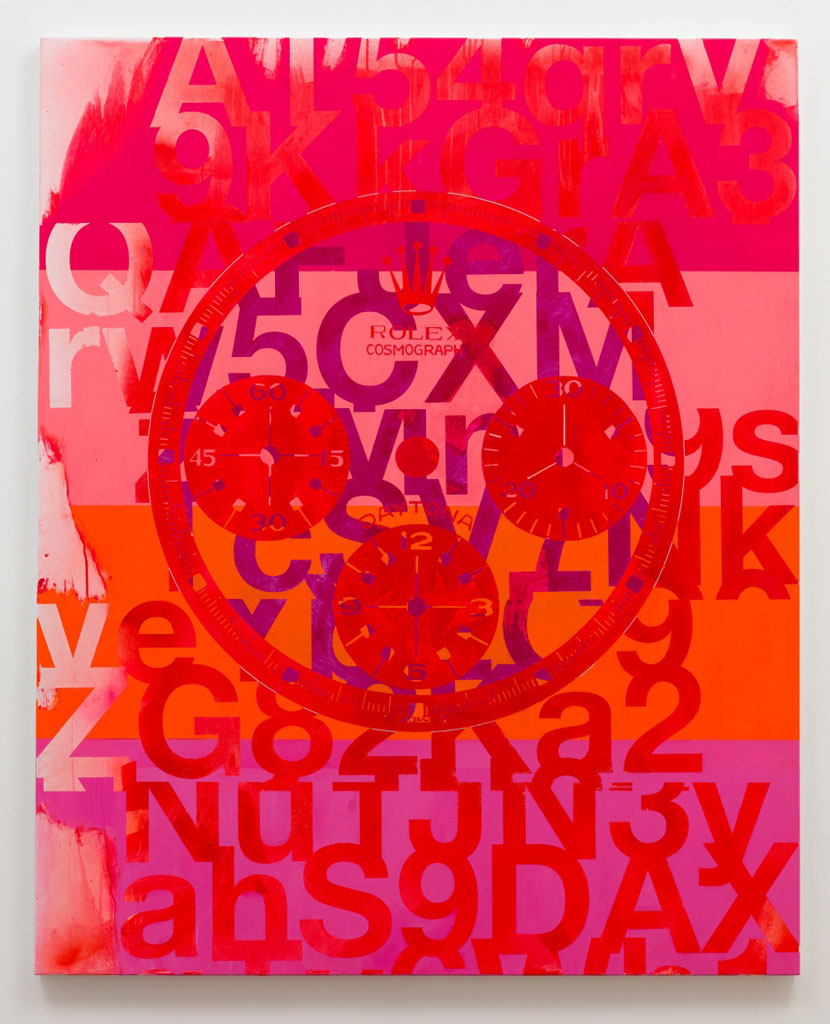 In the exhibition “Fractured Memories”, Johannes Wohnseifer looks back 25 years to his first solo exhibition in 1995 as a reference point. The very fact that 1995 was 25 years ago and time has passed seemingly so quickly feels like a “scandal“ to the artist and his latest series of paintings on aluminum are his reaction to this inevitability. In the new exhibition, Wohnseifer continues his critique of consumerism, capitalism and culture using the artistic language of Pop, Minimalism and Conceptualism, repurposing, reusing and co-opting logos, corporate branding, and design strategies to frame autobiographical, historical, political, and fictional data. The show’s title painting and central reference point uses a rendering of a – mostly redacted – press release from the Berlin gallery neugerriemschneider the site of Wohnseifer’s first solo show in 1995 at as source material, leaving only the gallery details and the phrase “fractured memories,” the composition recalling conceptual art of the 1960’s and 70’s. The monochromatic announcement cards used at the time by the Berlin gallery were designed by artist Jorge Pardo and the exhibiting artists were free to select their own personal color choice for the card. Wohnseifer opted for a fluorescent orange and this special “signal” color of Wohnseifer’s is an emblem that recurs throughout the new paintings in the current show, weaving a thread through time from that initial exhibition. Info: Meliksetian|Briggs, Gallery, 313 N Fairfax Avenue, West Hollywood, Duration: 25/1-21/3/20, Days & Hours: Tue-Sat 12:00-17:00, www.meliksetianbriggs.com
In the exhibition “Fractured Memories”, Johannes Wohnseifer looks back 25 years to his first solo exhibition in 1995 as a reference point. The very fact that 1995 was 25 years ago and time has passed seemingly so quickly feels like a “scandal“ to the artist and his latest series of paintings on aluminum are his reaction to this inevitability. In the new exhibition, Wohnseifer continues his critique of consumerism, capitalism and culture using the artistic language of Pop, Minimalism and Conceptualism, repurposing, reusing and co-opting logos, corporate branding, and design strategies to frame autobiographical, historical, political, and fictional data. The show’s title painting and central reference point uses a rendering of a – mostly redacted – press release from the Berlin gallery neugerriemschneider the site of Wohnseifer’s first solo show in 1995 at as source material, leaving only the gallery details and the phrase “fractured memories,” the composition recalling conceptual art of the 1960’s and 70’s. The monochromatic announcement cards used at the time by the Berlin gallery were designed by artist Jorge Pardo and the exhibiting artists were free to select their own personal color choice for the card. Wohnseifer opted for a fluorescent orange and this special “signal” color of Wohnseifer’s is an emblem that recurs throughout the new paintings in the current show, weaving a thread through time from that initial exhibition. Info: Meliksetian|Briggs, Gallery, 313 N Fairfax Avenue, West Hollywood, Duration: 25/1-21/3/20, Days & Hours: Tue-Sat 12:00-17:00, www.meliksetianbriggs.com
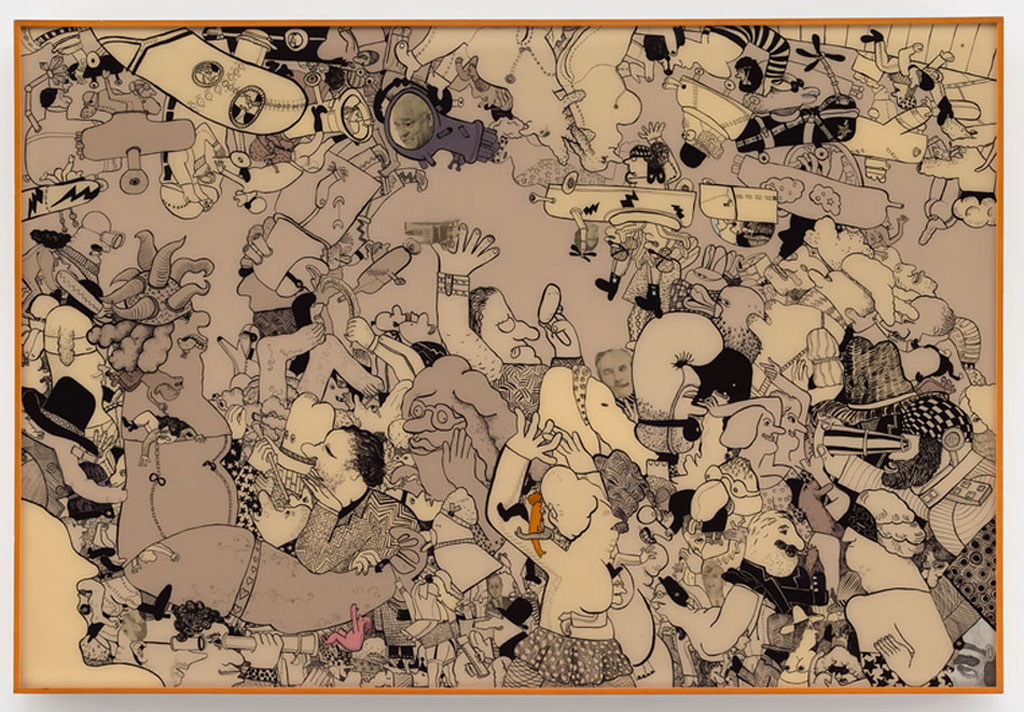 Featuring over forty works made between 1963 and 1980, Gladys Nilsson presents her exhibition “Honk! Fifty Years of Painting”. Though Nilsson is better known for the watercolors she began exhibiting in the mid-1960s as one of the original members of the Hairy Who, she has dedicated much of her career to painting with acrylic on canvas, panel, and Plexiglas. The earliest works in the exhibition depict brightly colored figures in enigmatic scenarios. In “Honk” (1964) a group of four figures at the left of the canvas confronts an uncannily similar group on the right, while in “Nightclub” (c. 1963–64) a giant lime-green face leers at a chorus line of dancers on an illuminated stage. Like many of Nilsson’s paintings, both works include wood frames designed by the artist. In 1966 Nilsson began painting on Plexiglas, applying paint to the opposite side so that it is seen through the clear plastic. Laying down each painting’s layers in reverse order yielded more graphic compositions. Her largest painting on Plexiglas, “Very Worldly” (1967), is included in the exhibition, it abounds with hundreds of characters of every conceivable size and shape, many of them piloting fantastical vehicles. After 1970 Nilsson returned to working on canvas, and although graphic figures still populate her paintings, they are often anchored by a single protagonist. Info: Matthew Marks Gallery, 523 West 24th Street, New York: Duration: 31/1-18/4/20. Days & Hours: Tue-Sat 10:00-18:00, www.matthewmarks.com
Featuring over forty works made between 1963 and 1980, Gladys Nilsson presents her exhibition “Honk! Fifty Years of Painting”. Though Nilsson is better known for the watercolors she began exhibiting in the mid-1960s as one of the original members of the Hairy Who, she has dedicated much of her career to painting with acrylic on canvas, panel, and Plexiglas. The earliest works in the exhibition depict brightly colored figures in enigmatic scenarios. In “Honk” (1964) a group of four figures at the left of the canvas confronts an uncannily similar group on the right, while in “Nightclub” (c. 1963–64) a giant lime-green face leers at a chorus line of dancers on an illuminated stage. Like many of Nilsson’s paintings, both works include wood frames designed by the artist. In 1966 Nilsson began painting on Plexiglas, applying paint to the opposite side so that it is seen through the clear plastic. Laying down each painting’s layers in reverse order yielded more graphic compositions. Her largest painting on Plexiglas, “Very Worldly” (1967), is included in the exhibition, it abounds with hundreds of characters of every conceivable size and shape, many of them piloting fantastical vehicles. After 1970 Nilsson returned to working on canvas, and although graphic figures still populate her paintings, they are often anchored by a single protagonist. Info: Matthew Marks Gallery, 523 West 24th Street, New York: Duration: 31/1-18/4/20. Days & Hours: Tue-Sat 10:00-18:00, www.matthewmarks.com
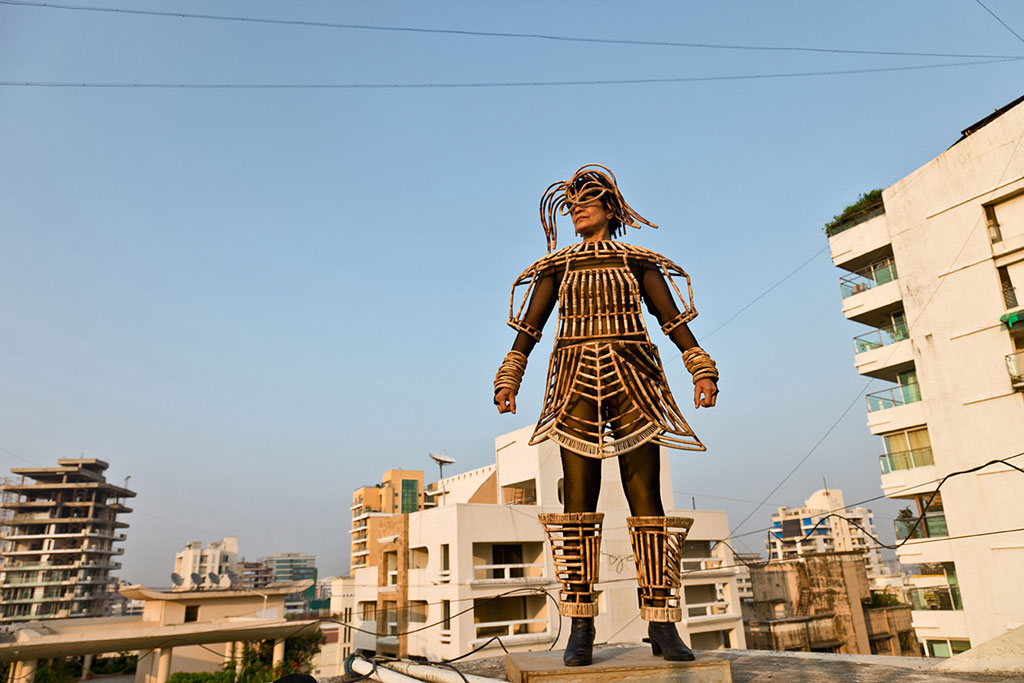 The exhibition “Unhomed” brings together a group of international artists, whose artistic practices are in constant dialogue with the complex narratives of cultural heritage, history writing and freedom of speech. Their art is researching borders in relation to public and domestic spaces of rapidly changing cities, like Mumbai, Karachi and Moscow, underlining processes of decolonialisation and national aspirations. The artworks in the exhibition span from geopolitical structures and urban development to intimate narratives of physical vulnerability. Through the mediums of performative actions and moving images and sculpture the artworks destabilise the notion of identity and what is to be considered a national or personal ”home”. The concept Unhomed is also quoted from the poetic work of Shilpa Gupta Words come from Ears. In this context the word is entangled with experiences of migration and movement. A global condition where inner and outer boundaries are crossed. Participating Artists: Shilpa Gupta, Shakuntala Kulkarni, Nadia-Kaabi Linke, Sirous Namazi, Zahra Malkani & Shahana Rajani, Lap-See Lam, Alexandra Mitlyanskaya. Info: Curator: Rebecka Wigh Abrahamsson, Uppsala Art Museum, Drottning Christinas väg 1E, Uppsala, Duration: 1/2-10/5/20, Days & Hours: Tue-wed & Fri-Sun 11:30-16:00, Thu 11:30-20:00, http://uppsalakonstmuseum.se
The exhibition “Unhomed” brings together a group of international artists, whose artistic practices are in constant dialogue with the complex narratives of cultural heritage, history writing and freedom of speech. Their art is researching borders in relation to public and domestic spaces of rapidly changing cities, like Mumbai, Karachi and Moscow, underlining processes of decolonialisation and national aspirations. The artworks in the exhibition span from geopolitical structures and urban development to intimate narratives of physical vulnerability. Through the mediums of performative actions and moving images and sculpture the artworks destabilise the notion of identity and what is to be considered a national or personal ”home”. The concept Unhomed is also quoted from the poetic work of Shilpa Gupta Words come from Ears. In this context the word is entangled with experiences of migration and movement. A global condition where inner and outer boundaries are crossed. Participating Artists: Shilpa Gupta, Shakuntala Kulkarni, Nadia-Kaabi Linke, Sirous Namazi, Zahra Malkani & Shahana Rajani, Lap-See Lam, Alexandra Mitlyanskaya. Info: Curator: Rebecka Wigh Abrahamsson, Uppsala Art Museum, Drottning Christinas väg 1E, Uppsala, Duration: 1/2-10/5/20, Days & Hours: Tue-wed & Fri-Sun 11:30-16:00, Thu 11:30-20:00, http://uppsalakonstmuseum.se
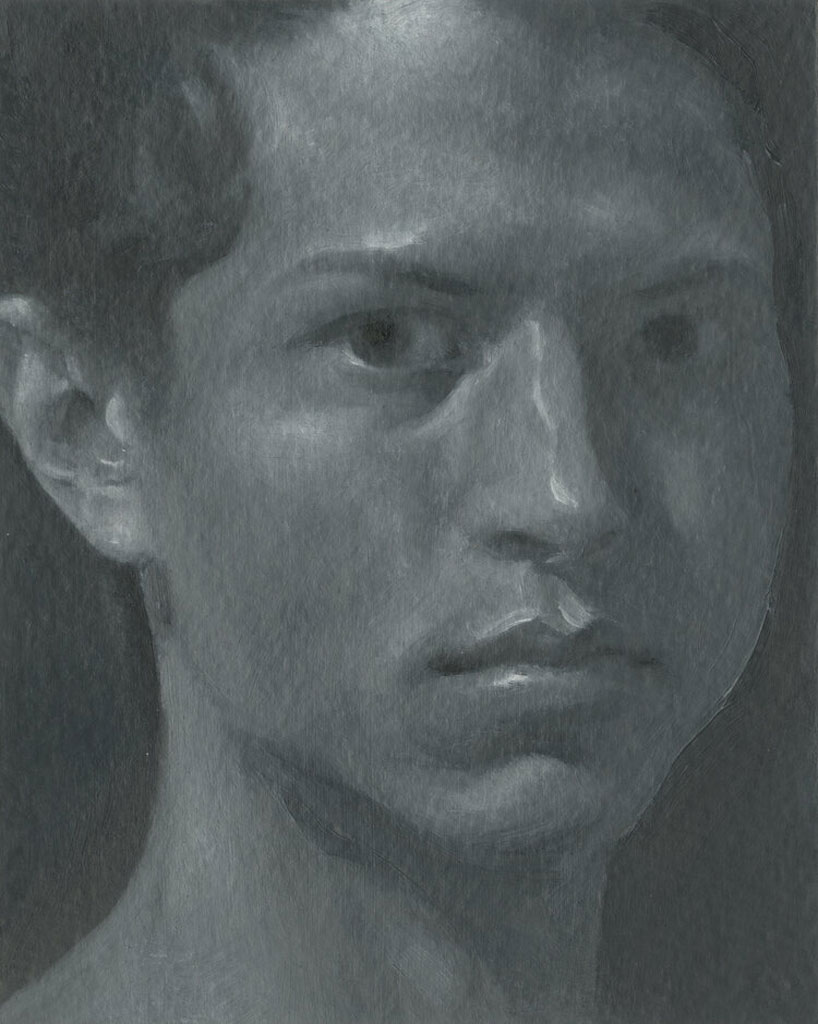 In Xavier Robles de Medina’s exhibition “Faya Lobi” there is a drawing of a photograph of his grandfather and his colleague while the statue of Queen Wilhelmina is being placed in front of Fort Zeelandia, a fortress in Paramaribo, Suriname. Xavier’s work is a slow excavation, conjuring, a resuscitation, a long and extended dedication. Xavier’s working drawing process is slow and determined. In our conversations, he says he is mostly erasing away. From seeing the way the images progress, it feels like coming upon a clearing after a long dim-lit path. Xavier Robles de Medina produces observational drawings alongside objective dissections of the painting as a three-dimensional object. A process that works away at the original source, Robles de Medina translates images back and forth between varying mediums and alternating views, establishing a lineage between the origins of the image and the newly emerged form. He is currently studying the visual cues and contextual idiosyncrasies within the photographs and documentary films of Surinam’s past and present history. In 2015 the artist was the youngest nominee for the Prix de Rome Visual Arts (Netherlands) and also completed residency programs at WOW Amsterdam and CTG. Info: Galerie Praz-Delavallade, 5 rue des Haudriettes, Paris, Duration: 1/2-21/3/20, Days & Hours: Tue-Sat 11:00-19:00, www.praz-delavallade.com
In Xavier Robles de Medina’s exhibition “Faya Lobi” there is a drawing of a photograph of his grandfather and his colleague while the statue of Queen Wilhelmina is being placed in front of Fort Zeelandia, a fortress in Paramaribo, Suriname. Xavier’s work is a slow excavation, conjuring, a resuscitation, a long and extended dedication. Xavier’s working drawing process is slow and determined. In our conversations, he says he is mostly erasing away. From seeing the way the images progress, it feels like coming upon a clearing after a long dim-lit path. Xavier Robles de Medina produces observational drawings alongside objective dissections of the painting as a three-dimensional object. A process that works away at the original source, Robles de Medina translates images back and forth between varying mediums and alternating views, establishing a lineage between the origins of the image and the newly emerged form. He is currently studying the visual cues and contextual idiosyncrasies within the photographs and documentary films of Surinam’s past and present history. In 2015 the artist was the youngest nominee for the Prix de Rome Visual Arts (Netherlands) and also completed residency programs at WOW Amsterdam and CTG. Info: Galerie Praz-Delavallade, 5 rue des Haudriettes, Paris, Duration: 1/2-21/3/20, Days & Hours: Tue-Sat 11:00-19:00, www.praz-delavallade.com
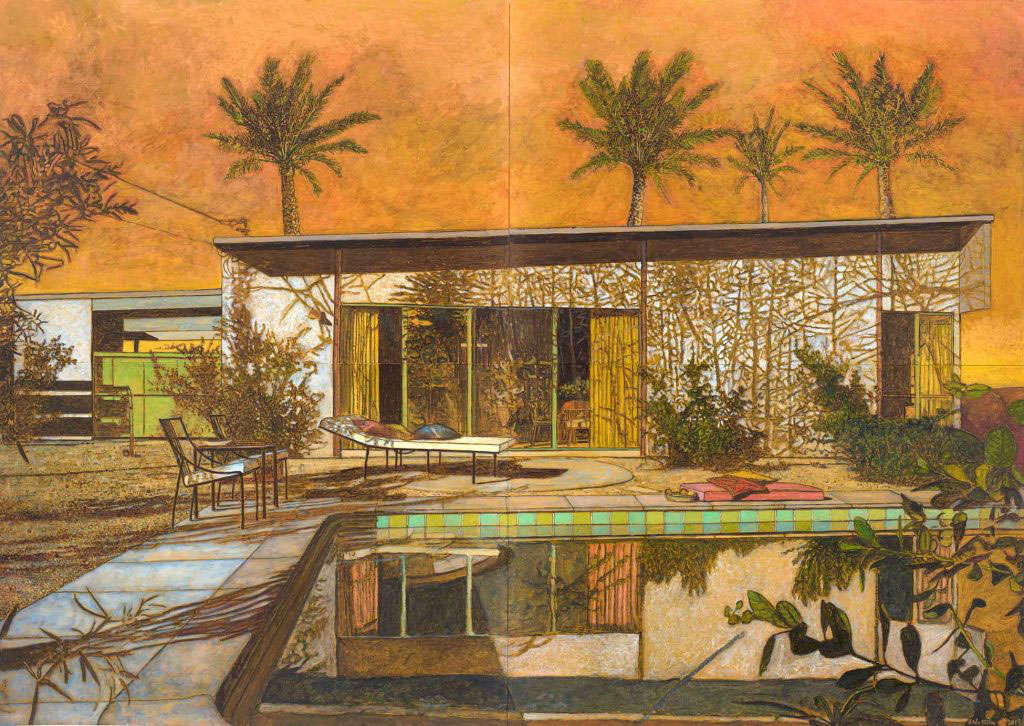 Stefan Kürten’s paintings in his exhibition “True Colors” explore the complexities of our universal yearning for the ideal place to call home. His source material includes appropriated images from architecture and design magazines as well as photographs he has taken during his global travels. These become starting points for carefully constructed scenes whose idyllic environments belie their illusory promise of ultimate happiness. The seductive fantasy of the good life takes a variety of forms. Mid-century-style homes in meticulously landscaped surroundings are adorned with iconic modern art and design objects. Charming cottages in bucolic environs suggest an escape to a simpler life. Swimming pools and palm trees evoke a relaxed lifestyle of golf-filled days and warm, cocktail-soaked nights. There is a deceptive familiarity to Kürten’s depictions. They may seem at first like enviable places, but they become unsettling upon closer examination. Misshapen trees, apocalyptic skies, and precarious hillsides suggest a subtly sinister force at play. Dead grass and traces of graffiti conjure abandonment and decay. Rorschach-like reflections within the compositions signal a dizzying hallucination. Such unexpected disturbances expose darker truths underlying the emblems of Western prosperity. Info: Hosfelt Gallery, 260 Utah Street, San Francisco, Duration 1/2-21/3/20, Days & Hours: Tue-Wed & Fri-Sat 10:00-17:30, Thu 11:00-19:00, http://hosfeltgallery.com
Stefan Kürten’s paintings in his exhibition “True Colors” explore the complexities of our universal yearning for the ideal place to call home. His source material includes appropriated images from architecture and design magazines as well as photographs he has taken during his global travels. These become starting points for carefully constructed scenes whose idyllic environments belie their illusory promise of ultimate happiness. The seductive fantasy of the good life takes a variety of forms. Mid-century-style homes in meticulously landscaped surroundings are adorned with iconic modern art and design objects. Charming cottages in bucolic environs suggest an escape to a simpler life. Swimming pools and palm trees evoke a relaxed lifestyle of golf-filled days and warm, cocktail-soaked nights. There is a deceptive familiarity to Kürten’s depictions. They may seem at first like enviable places, but they become unsettling upon closer examination. Misshapen trees, apocalyptic skies, and precarious hillsides suggest a subtly sinister force at play. Dead grass and traces of graffiti conjure abandonment and decay. Rorschach-like reflections within the compositions signal a dizzying hallucination. Such unexpected disturbances expose darker truths underlying the emblems of Western prosperity. Info: Hosfelt Gallery, 260 Utah Street, San Francisco, Duration 1/2-21/3/20, Days & Hours: Tue-Wed & Fri-Sat 10:00-17:30, Thu 11:00-19:00, http://hosfeltgallery.com
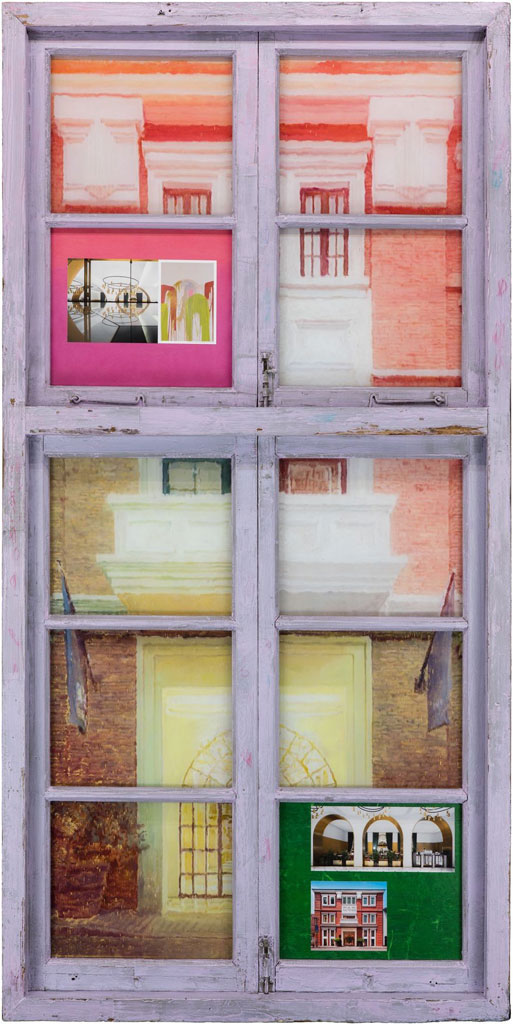 Overrun with mysteries, fake news, innuendos and double meanings, “Blow Up” is a visual wandering in which Li Qing, a leading figure of the new generation of Chinese artists born in the ’80s, confronts us with different ways of understanding, reading, decoding and interpreting the appearances of reality. From painting to installation, sound pieces to video and photography, his work is a verse of contemporary urban poetry engaging in a new logic of visuality. Li Qing’s work reflects on the contemporary aesthetics of the megacities that are changing at a considerable rate and the evolution of society through architectural alterations that are often closely related to human existence as an extension of our past experiences. In his “Neighbor’s Window” (2016-19), using the back of old window frames from buildings of the French concession in Shanghai that had been demolished, he elaborates on Leon Battista Alberti’s metaphorical definition of the painting as an “open window through which we can look at history”, through nested windows and multiple images that coexist and overlap. His position is always that of the observer, that expresses his critiques through games or irony. Interaction has always been a key aspect of his work, which is utilized to unblock our mechanisms of vision, especially a vision steeped in the thrall of today’s post-digital era. Info: Curator: Jérôme Sans, Almine Rech Gallery, Grosvenor Hill, Broadbent House, London, Duration: 5/2-7-3/20, Days & Hours: Tue-Sat 10:00-18:00, www.alminerech.com
Overrun with mysteries, fake news, innuendos and double meanings, “Blow Up” is a visual wandering in which Li Qing, a leading figure of the new generation of Chinese artists born in the ’80s, confronts us with different ways of understanding, reading, decoding and interpreting the appearances of reality. From painting to installation, sound pieces to video and photography, his work is a verse of contemporary urban poetry engaging in a new logic of visuality. Li Qing’s work reflects on the contemporary aesthetics of the megacities that are changing at a considerable rate and the evolution of society through architectural alterations that are often closely related to human existence as an extension of our past experiences. In his “Neighbor’s Window” (2016-19), using the back of old window frames from buildings of the French concession in Shanghai that had been demolished, he elaborates on Leon Battista Alberti’s metaphorical definition of the painting as an “open window through which we can look at history”, through nested windows and multiple images that coexist and overlap. His position is always that of the observer, that expresses his critiques through games or irony. Interaction has always been a key aspect of his work, which is utilized to unblock our mechanisms of vision, especially a vision steeped in the thrall of today’s post-digital era. Info: Curator: Jérôme Sans, Almine Rech Gallery, Grosvenor Hill, Broadbent House, London, Duration: 5/2-7-3/20, Days & Hours: Tue-Sat 10:00-18:00, www.alminerech.com
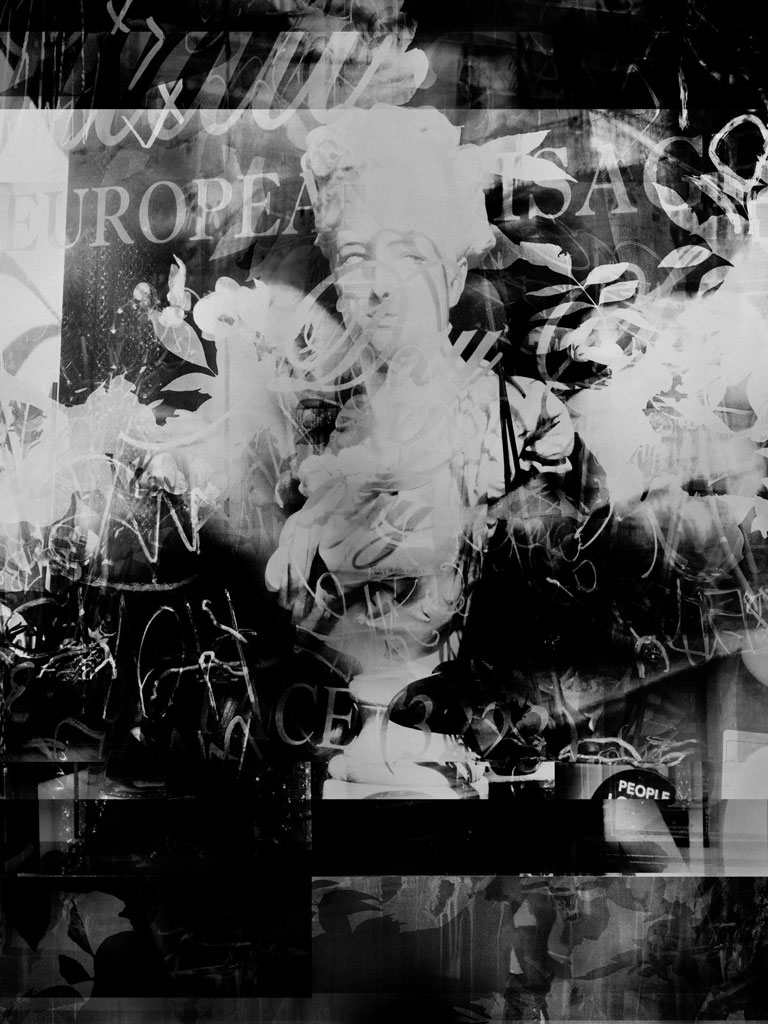 For her new series, “Reflection” has worked on superimposing various previously unpublished photographs of shop windows and storefronts in Manhattan and other cities in New York state. She thus revisits a recurring theme in her work since the 1990s. The photographic collection of the Victoria & Albert Museum has been a resource for the artist, whether it be photographs created by the Worsinger Window Service (or Worsinger Photo) – a New York firm that specialized in documenting shop windows and interiors – or Robert Brownjohn’s Street Level series focused on photographs of signs and typographies. The artist also refers to the work of Eugène Atget and of Walker Evans, the photographer par excellence of vernacular American culture, or even the photographs of Lee Friedlander. A shop window is presented as a small urban theatre open to the street where goods are displayed and staged against a backdrop of decor. The shop window has always been a source of inspiration for Valérie Belin. In the early 90s, she first made photographs of jewelry and trinkets exposed in different shopping malls. Subsequently there came photographs of crystal vases and silverware (Verres I et Verres II, 1993-1994), photographs of glass objects and mirrors in several showrooms in Venice (Venise I, 1997), photographs of mannequins (Mannequins, 2003), and finally, photographs of storefronts in Luxembourg (Vitrines Luxembourg, 2003). Info: Galerie Nathalie Obadia, 3, rue du Cloître Saint-Merri, Paris, Duration: 6/2-4/4/20, Days & Hours: Mon-Sat 11:00-10:00, https://nathalieobadia.com
For her new series, “Reflection” has worked on superimposing various previously unpublished photographs of shop windows and storefronts in Manhattan and other cities in New York state. She thus revisits a recurring theme in her work since the 1990s. The photographic collection of the Victoria & Albert Museum has been a resource for the artist, whether it be photographs created by the Worsinger Window Service (or Worsinger Photo) – a New York firm that specialized in documenting shop windows and interiors – or Robert Brownjohn’s Street Level series focused on photographs of signs and typographies. The artist also refers to the work of Eugène Atget and of Walker Evans, the photographer par excellence of vernacular American culture, or even the photographs of Lee Friedlander. A shop window is presented as a small urban theatre open to the street where goods are displayed and staged against a backdrop of decor. The shop window has always been a source of inspiration for Valérie Belin. In the early 90s, she first made photographs of jewelry and trinkets exposed in different shopping malls. Subsequently there came photographs of crystal vases and silverware (Verres I et Verres II, 1993-1994), photographs of glass objects and mirrors in several showrooms in Venice (Venise I, 1997), photographs of mannequins (Mannequins, 2003), and finally, photographs of storefronts in Luxembourg (Vitrines Luxembourg, 2003). Info: Galerie Nathalie Obadia, 3, rue du Cloître Saint-Merri, Paris, Duration: 6/2-4/4/20, Days & Hours: Mon-Sat 11:00-10:00, https://nathalieobadia.com
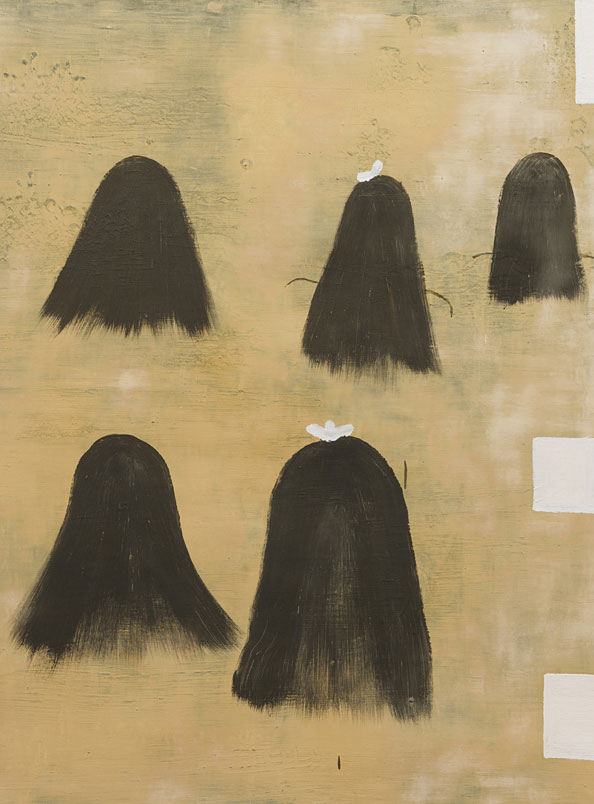 In the exhibition “Five Women In Japan” are on show Norbert Schwontkowski’s works from from the Böckmann Collection. Norbert Schwontkowski challenges artistic categorization; his work falls between abstraction, realistic representation, and cartoon. He created his paints from hand-ground pigments mixed with various materials to yield a multitude of textures. Schwontkowski also added metal oxides to the pigments, creating shimmering surfaces that continue to change over time. His palette of pale earth tones, blacks and grays creates a muted, subdued atmosphere, while his carefully worked surfaces and minimal gestures demonstrate his sophisticated paint handling. Norbert Schwontkowski’s career divides neatly, if unequally, into two sections. Until his mid fifties, the Bremen-born painter was little known outside of northern Germany. In 2004, however, after decades combining painting, teaching, travel and dogged quietude, he enjoyed a retrospective at Since then, up to and after his early death in 2013, Schwontkowski’s murkily atmospheric, mostly figurative scenarios have been increasingly visible, their maker appearing like something of a throwback figure in using painting to wrestle so emphatically with existential disquiet and a neo-Romantic sense of the numinous. Info: Neues Museum Nürnberg, Luitpoldstraße 5, Nürnberg, Duration: 6/2/20- , Days & Hours: Tue-Wed & Fri-Sun 10:00-18:00, Thu 10:00-20:00, www.nmn.de
In the exhibition “Five Women In Japan” are on show Norbert Schwontkowski’s works from from the Böckmann Collection. Norbert Schwontkowski challenges artistic categorization; his work falls between abstraction, realistic representation, and cartoon. He created his paints from hand-ground pigments mixed with various materials to yield a multitude of textures. Schwontkowski also added metal oxides to the pigments, creating shimmering surfaces that continue to change over time. His palette of pale earth tones, blacks and grays creates a muted, subdued atmosphere, while his carefully worked surfaces and minimal gestures demonstrate his sophisticated paint handling. Norbert Schwontkowski’s career divides neatly, if unequally, into two sections. Until his mid fifties, the Bremen-born painter was little known outside of northern Germany. In 2004, however, after decades combining painting, teaching, travel and dogged quietude, he enjoyed a retrospective at Since then, up to and after his early death in 2013, Schwontkowski’s murkily atmospheric, mostly figurative scenarios have been increasingly visible, their maker appearing like something of a throwback figure in using painting to wrestle so emphatically with existential disquiet and a neo-Romantic sense of the numinous. Info: Neues Museum Nürnberg, Luitpoldstraße 5, Nürnberg, Duration: 6/2/20- , Days & Hours: Tue-Wed & Fri-Sun 10:00-18:00, Thu 10:00-20:00, www.nmn.de
